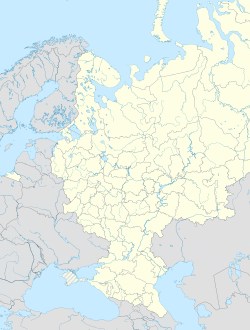Amusgi
| Village
Amusgi
Амузги
|
||||||||||||||||||||||
|
||||||||||||||||||||||
|
||||||||||||||||||||||
Amusgi ( Russian Амузги ; scientific transliteration Amuzgi ) is a now abandoned village. It is located in Dachadayevsky Raion in the North Caucasian Republic of Dagestan in the Russian Federation .
Amusgi is 4–5 kilometers southwest of Kubatschi . Amusgi was an important center of blacksmithing in the past; it was particularly famous in Dagestan and beyond for its edged weapons . The iron and steel everyday and agricultural implements produced in Amusgi - knives, scissors, axes, hoes, sickles, locks, nails - as well as tools for the craftsmen from Kubatschi enjoyed great demand.
A dialect of the Dargin language was spoken in Amusgi , which is very different from Dargin and is often called "Cubachin" . There are small differences between the dialects of Kubatschi and Amusgi.
Origin of the place name
Amusgi is a later creation. On Kubatschinisch is the village ГӀямудже / ГӀябмудже ( IPA : ʕjamudʒe) ʕjamudgan - the Amusginer . In Cuban ʕjab means three, muda means mountain, and -an is the suffix for a resident of a particular place. The place name can therefore be translated as "village on three hills".
Weir systems
In the Middle Ages, the village of Amusgi was heavily fortified. In the south of the village there is a rock wall more than 100 meters high; in the west and north-east, in the 12th – 13th centuries. Century a - partially preserved - fortress wall was built. The wall is about 1.4 meters thick at its end and today 1.5–3 meters high in various places. There were also round defense towers; these were later partially converted into residential buildings. The only entrance to the village was in the east - an archway 2 meters high and 1.5 meters wide.
economy
Amusgi was always very closely related to Kubatschi economically. According to EM Schilling, Amusgi and Kubatschi coexisted like a single large manufacture: the sabers and blades were made in Amusgi, which were then sheathed and warped by the famous Kubatschin craftsmen.
Perhaps a message from Abu Khamid al-Garnati from the 12th century refers to Kubatschi and Amusgi, according to which “there is a large mountain not far from Derbent , at the foot of which there are two villages. In them lives a people called 'sirichgeran' [...]. They manufacture all kinds of war equipment [...] "
From the Middle Ages until the 1930s, Amusgi remained one of the great centers for the manufacture of saber and dagger blades; the entire adult population, including women and young people, was engaged in this craft. It was only after the demand for edged weapons subsided in the 1930s that the population began to practice agriculture, although some craftsmen continued to practice blacksmithing.
Deportation of the population of Amusgi and further development
The population of Amusgi was deported to Derbent Rajon or Chechnya in 1944 and only partially returned later. In the 1980s the village had about 40 inhabitants. Today the village is deserted, but has the OKATO code , which is still valid, 82 218 860 002as a place subordinate to the Uragi village soviet (today the rural community of the same name, selskoje posselenije ). Uragi is about 2.5 kilometers as the crow flies west of Amusgi on the same side of the valley.
Amusgi in literature
The Dagestani writer Rassul Gamsatov wrote a poem called The Amusgins ( Amusginsy ).
swell
- ↑ a b M.M. Mammaev: Zirichgeran - Kubači. Očerki po istorii i kul'ture. Machačkala, 2005. pp. 61-65
- ↑ MM Mammaev: Zirichgeran - Kubači. Očerki po istorii i kul'ture. Machačkala, 2005. p. 62
- ↑ a b M.M. Mammaev: Zirichgeran - Kubači. Očerki po istorii i kul'ture. Machačkala, 2005. p. 63
- ↑ Soviet General Staff Map 1: 100,000. Sheet K-38-72 (edition 1985)

